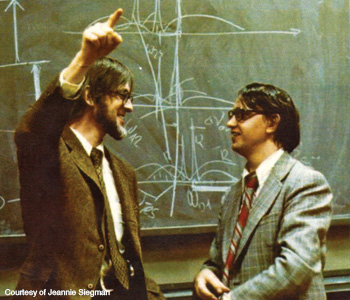 A bearded Tony Siegman talks with Russian scientist Vladilen Letokhov, visiting Stanford in 1974.
A bearded Tony Siegman talks with Russian scientist Vladilen Letokhov, visiting Stanford in 1974.
Talk to anyone who studied or worked with Anthony E. Siegman, and they will say: He clarified things. He took complex concepts and helped people understand them.
Siegman, a Stanford University (U.S.A.) electrical engineering professor usually called “Tony,” died in 2011, a few weeks before he would have turned 80. But in many ways, his technical and educational legacies are continuing onward. Not only did several generations of his students go on to illustrious careers in optics, but his reference book on laser physics remains in print as a frequently cited authority.
And this August, the first Siegman International School on Lasers opens its doors on the Stanford campus. Over the past two years, Siegman’s colleagues and friends have worked through the OSA Foundation to create an intensive educational opportunity for graduate students from around the world. “There is nothing that could be a more fitting honor to Tony,” says his widow, Virginia “Jeannie” Siegman of Stanford, Calif., U.S.A.
By all accounts, Siegman spoke modestly about his own considerable achievements, but he was always lending an ear and giving advice to early-career researchers. He led OSA through one of its most fractious years at the end of the 20th century and served the OSA Foundation as a board member in its early years.
|
From the Midwest to Massachusetts
Born in Detroit, Mich., on 23 November 1931, Siegman was the oldest of three boys in a family with, as Jeannie Siegman put it, “a lot of native strength of character and capability.” Both of his parents were educated: his mother had worked as a schoolteacher, and his father served as the controller of an ice and fuel company in Detroit. The family lived a good distance from Detroit in the lake-strewn rural area northwest of the city.
Young Tony went to local schools at first, and then matriculated at the all-boys Catholic Central High School in Detroit. That phase of his education required him to commute to the big city with his father every weekday—an opportunity that strengthened their father-son bond. Outside of school, Tony repaired an elderly outboard motor for boating on the nearby lake.
Later in life, Siegman did not remember a single “eureka” moment in which he decided to pursue a career in science and engineering. As a teenager he took a vocational-interest test, which predicted he would be a good fit for clerical work—a result that he attributed to his father’s accounting background. “But I think where it may have been a valid assessment,” he recounted, “is that I have always gotten satisfaction from collecting ideas and analyses and scientific principles in whatever it is I’m working on, and reading a lot of papers and collecting references, and trying to bring those all together into a unified, clear presentation.”
In the late 1940s, Harvard University was trying to shed its image as the mecca for East Coast aristocrats. Under the leadership of its president, James Bryant Conant, Harvard instituted a “national scholar” program through which two students from each state would receive sizable scholarships. Although the Catholic Central faculty might have preferred that their graduating seniors attend the University of Notre Dame, in 1949 Siegman became one of the two scholarship winners from Michigan and chose to take Harvard up on its offer.
Since Harvard had no engineering school, Siegman followed the “engineering science and applied physics” track within the physics department. He chose to take five courses per semester instead of the usual four, and after two years he realized that he might be able to graduate sooner rather than later. So he took a couple of extra summer classes and received his bachelor’s degree in 1952. “And, again much to my surprise at the time as I hadn’t even been thinking about this, I learned I had graduated summa cum laude in three years flat,” he recounted.
Westward to California
Upon his Ivy League graduation, Siegman accepted a corporate fellowship at Hughes Research Laboratories in southern California. The program required entry-level engineers to split their workweeks between their jobs and their graduate studies, so that after two years they would earn a master’s degree in applied physics. Not surprisingly, Siegman finished up the academic work in a year and a half.
While getting the degree from the University of California at Los Angeles, Siegman was assigned to the Hughes microwave tube laboratory. He studied the traveling wave tube: a microwave tube with a huge bandwidth, which was then of great interest for replacing telephone lines with microwave links, plus other applications in satellite and military communications. He attended an invitation-only annual gathering known as the “Electron Tube Conference,” in which scientists freely discussed their latest thoughts and experiments off the record—no press, no photographs, not even any citations in academic journals. There, the young Siegman rubbed elbows with Bell Telephone Laboratories researchers such as Ivan Kaminow and Arthur Ashkin.
Siegman’s first boss at Hughes was Dean A. Watkins, who left after a year to take a faculty position at Stanford University. Shortly thereafter, Watkins invited Siegman and another Hughes fellow to come study for a doctorate in engineering, so in 1954 Siegman went to Palo Alto. He did a thesis on noise in electron beams, using Stanford’s first mainframe computer—punch cards and all.
Even before he finished his Ph.D., Stanford hired Siegman on as an acting assistant professor so that he could teach an electrical engineering class. “So now I’ve gone from graduating from high school to at least an acting professor appointment in seven years, which is—well, surely the result of a lot of fortunate circumstances,” he said. He formally received his doctorate the following year, 1957.
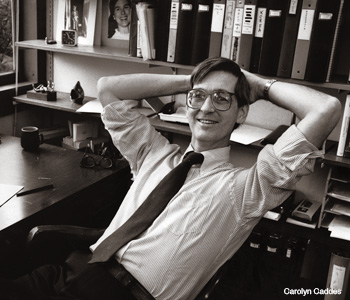 Siegman in his office in the old Ginzton Lab building.
Siegman in his office in the old Ginzton Lab building.
From masers to lasers
By 1958, Arthur L. Schawlow and Charles H. Townes had come out with their landmark theoretical paper on optical masers. Siegman was compiling the notes from the classes he was teaching on microwave masers, and he would publish them in the early 1960s as the first of his three books. But even as he was working hard on the subject, the scientific community was moving beyond masers to lasers.
Because Siegman had met Townes at one of the Electron Tube Conferences, the Columbia University physicist invited the young Stanford engineer to join the program committee of the International Conference on Quantum Electronics. Also invitation-only, the September 1959 gathering brought together a few hundred researchers at Shawanga Lodge, a resort in the Catskills northwest of New York City. Siegman called himself “by far, the youngest guy and the least distinguished” among the program committee members, who included future Nobelists Townes and Nicolaas Bloembergen as well as Rudy Kompfner, the inventor of the traveling wave tube.
The nonlinear-optics research on the Stanford campus grew out of the microwave group at the Ginzton Laboratory, which was then housed in its original building (it has since been razed). Robert L. Byer, OSA’s 1994 President, calls the atmosphere there “incredibly productive.”
In May 1960, the news of Theodore Maiman’s ruby laser sent the Ginzton Lab into a tizzy. Siegman and other young faculty members and students were trying to figure out new ways to improve the laser. Siegman and his first graduate student in lasers, Burton J. McMurtry, published an article in the very first issue of Applied Optics in 1962—the title referred to “ruby optical masers,” which sounds quaint today.
“Tony in 1960-61 was essentially like Tony at the end of his life in that he was very smart, very open, an exceptionally comfortable person and easy to deal with,” says McMurtry, who eventually became a Silicon Valley venture capitalist. (When McMurtry and his wife endowed a professorial chair at Stanford, Siegman became the first to hold it.)
Byer first met Siegman when he hosted a series of lunchtime talks on nonlinear optics. As Byer recalls, he bicycled over to the Stanford campus from his job in nearby Mountain View, and the talks inspired him to apply to the university for his Ph.D. As a graduate student, Byer had hoped to work with Siegman, but Siegman assigned him instead to an even younger professor: Stephen E. Harris, Siegman’s second graduate student in lasers, now an OSA Honorary Member.
Besides his work on lasers, Siegman took an interest in the quantization of light, according to Byer and Harris. In 1961, along with two Bell Labs researchers, W.H. Louisell (now deceased) and Amnon Yariv (now at California Institute of Technology), Siegman published an important early paper on quantum noise in linear amplifiers; the three authors predicted what is now called parametric fluorescence.
Because of his early work on microwave tubes, Siegman was interested in laser cavities and mirrors. Scientists, especially A. Gardner Fox and Tingye Li at Bell Labs, were gaining an understanding of stable optical resonators, based on real-number solutions to laser equations. In 1965, Siegman took the imaginary-number solutions and, instead of discarding them, used them to devise a so-called unstable resonator that would become an important component of high-power lasers.
In 1986 Siegman published his third and final book, simply titled Lasers. “We call it the ‘bible on lasers,’” Byer says. “He [Siegman] took great care that the work he wrote up was precisely correct in all aspects.” According to Jeannie Siegman, Tony chose a comparatively small publisher, University Science Books, to publish Lasers because it was willing to import his carefully crafted TeX files—not a common practice at that time. He wanted to minimize the number of errors in the finished product and to keep the price within the reach of many. In the early 1990s, Siegman, an early adopter of the personal computer, wrote several OPN articles on TeX, electronic publishing and the then-new World Wide Web.
Siegman’s meticulousness carried over to the lecture hall. “His classes were taught from handwritten notes, and they were very precisely done,” Byer says. “He always took questions and he never dismissed any question; [he] took it as an opportunity to explore a subject deeply. I was fortunate enough to co-teach a number of courses with Tony, and he was my mentor. I paid a lot of attention to how he organized his lectures, how he interacted with the students—all of those things matter, and Tony was just superb at teaching.”
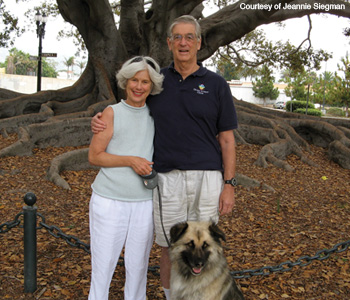 Jeannie and Tony Siegman on a visit to Santa Barbara, Calif., U.S.A., in 2007.
Jeannie and Tony Siegman on a visit to Santa Barbara, Calif., U.S.A., in 2007.
Family, friends and later years
Siegman married early in his Stanford years, but eventually he found himself a single parent of a daughter and two sons. In January 1974 he wed Virginia “Jeannie” Howard, who had a young daughter of her own. The six-member blended family settled in a home on the Stanford campus.
To accommodate Jeannie’s limitations in outdoor activities, Tony switched from downhill to cross-country skiing, and the newlyweds took a mule trip through Yosemite National Park. The Siegmans bought a cabin near Lake Tahoe, a starting point for many more outdoor adventures.
Toward the end of the 1990s, Siegman began thinking about retirement, and his plans to wind down his grant-funded research overlapped with his increase in OSA-related activities, culminating in his term as president of the society in 1999.
Over the following decade, Siegman continued to travel to meetings and give invited talks, including a LaserFest presentation on masers and microwave cavities on the exact 50th anniversary of Theodore Maiman’s first ruby laser. He published on subjects ranging from fiber lasers to optics trivia. Students always anticipated his occasional visits to the lab so that they could discuss aspects of their research with him. “His interest in science did not diminish,” Byer says.
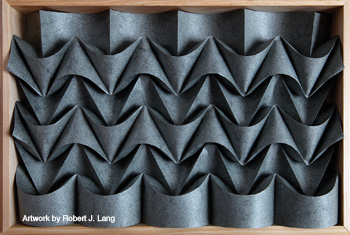 Origami depiction of the unstable laser resonator, created by OSA Fellow Robert J. Lang. Members of the Stanford Photonic Research Center presented this artwork to Tony Siegman in September 2011.
Origami depiction of the unstable laser resonator, created by OSA Fellow Robert J. Lang. Members of the Stanford Photonic Research Center presented this artwork to Tony Siegman in September 2011.
In September 2011, members of the Stanford Photonics Research Center threw Siegman a surprise party in anticipation of his upcoming 80th birthday. Siegman’s colleagues presented him with a unique gift: an origami sculpture of an unstable laser resonator, created by paper-folding artist (and OSA Fellow) Robert J. Lang.
The celebration was simply timed to happen during the center’s annual meeting, with the expectation that the guest of honor would be around on his actual 80th birthday. Just a few weeks later, though, Siegman suffered a massive stroke and died on 7 October 2011. His passing sent shock waves through the laser and nonlinear-optics communities.
When Byer was helping plan a tribute to Siegman for the 2012 CLEO conference, Byer says, “it was amazing how many people came up to me with a story that Tony had changed their life in some significant way.” For example, he adds, 1992 OSA President Joseph Goodman told Byer he wouldn’t have come to Stanford if Siegman hadn’t talked with him about the research there. “So again, Tony changed someone’s life just by being available and providing the information,” Byer adds.
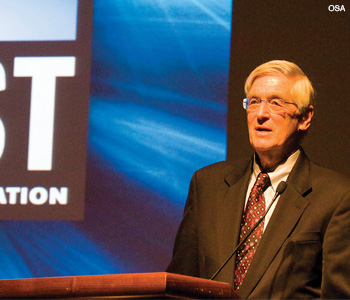 Siegman speaks at the 2010 LaserFest Gala.
Siegman speaks at the 2010 LaserFest Gala.
Building a living legacy
Shortly after Siegman’s passing, members of the optics community began to discuss how best to memorialize the man who had been a master teacher, researcher and OSA leader. Since Siegman’s last significant contribution to OSA had been his work on the organizing committee of a summer school on lasers in China, the OSA Foundation saw the opportunity to endow a permanent school on lasers in his name. Gary Bjorklund, the 1998 OSA President and past Foundation chair, spearheaded the fundraising campaign.
To begin the drive, Bjorklund and OSA CEO Elizabeth Rogan approached McMurtry and his wife, DeeDee, who donated $100,000. The Foundation team also received sizable gifts from several of Siegman’s past students as well as Coherent Inc., a company for which Siegman had done some consulting. Through a former Coherent executive, Bjorklund contacted Valentin P. Gapontsev, chairman and CEO of IPG Photonics Corp., who agreed to co-sponsor the school on his company’s behalf.
The first-ever Siegman International School on Lasers will take place during the first full week in August. Eric Van Stryland, OSA’s 2006 President, heads the steering and program committees, and the faculty includes Harris and Byer as well as OSA Fellows Hui Cao, Connie Chang-Hasnain, Alexander Gaeta, David Richardson, Bahaa E.A. Saleh and David Welch.
The Siegman International School “represents and recognizes Tony’s interest in helping people,” Byer says. Future goals for the school include holding it in different countries and providing scholarships for students from developing nations who otherwise could not afford to attend.
In life, Byer says, Tony Siegman always took time to interact with people and provide them with background and support. The Siegman School will provide that kind of beneficial interaction to future generations of students.
|
Patricia Daukantas is a freelance writer specializing in optics and photonics.
References and Resources
-
Quotations from Siegman are taken from the OSA oral history interview conducted on 5 May 2008, www.osa.org/en-us/history/biographies/anthony-e-siegman.
-
For more on the summer school that bears his name, visit www.osa.org/siegman.
Correction: The caption to the image of a “bearded Tony Siegman” has been changed to identify Vladilen Letokhov, whose identity was omitted in the original posting.

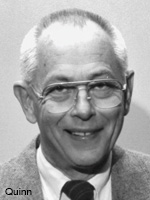 Siegman served on the OSA Board while Peter Franken served as OSA President in 1977. The executive director at the time, Jarus Quinn, asked Siegman several times if he would stand as a candidate for vice president, but Siegman demurred because of his involvements with family and career. Finally, he let his name be placed on the 1996 ballot because he had already been planning to wind down his contract-sponsored research at the end of 1998.
Siegman served on the OSA Board while Peter Franken served as OSA President in 1977. The executive director at the time, Jarus Quinn, asked Siegman several times if he would stand as a candidate for vice president, but Siegman demurred because of his involvements with family and career. Finally, he let his name be placed on the 1996 ballot because he had already been planning to wind down his contract-sponsored research at the end of 1998.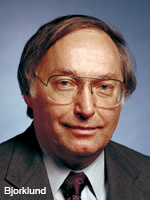 Siegman won the vote and embarked on the four-year leadership track, from vice president in 1997 to past president in 2000. “I can’t say enough about what a great guy he was to work with,” says 1998 OSA President Gary Bjorklund.
Siegman won the vote and embarked on the four-year leadership track, from vice president in 1997 to past president in 2000. “I can’t say enough about what a great guy he was to work with,” says 1998 OSA President Gary Bjorklund.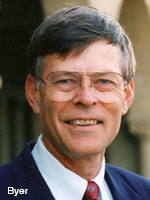 Building upon an idea that had been floated a decade earlier, the two societies set up a joint task force to investigate whether OSA, SPIE and perhaps other associations should band together under an umbrella organization for optics. In the end, the merger did not come to pass. The OSA-SPIE debate took more time than anything else during Siegman’s presidency, according to Byer, but Siegman handled it diplomatically and fairly, and he listened to both sides while sharing his own opinion.
Building upon an idea that had been floated a decade earlier, the two societies set up a joint task force to investigate whether OSA, SPIE and perhaps other associations should band together under an umbrella organization for optics. In the end, the merger did not come to pass. The OSA-SPIE debate took more time than anything else during Siegman’s presidency, according to Byer, but Siegman handled it diplomatically and fairly, and he listened to both sides while sharing his own opinion.